Impact of Augmented Reality on Student Motivation in the Context of an Immunity Course
Rim Laribi1, Adel Fridhi1-3*, Rahim Kouki1 and Naila Bali2,3
1Higher Institute of Childhood Executives (ISCE), University of Carthage, Tunisia
2Higher Institute of Special Education, Tunisia
3Research Laboratory on Disability and Social Unsuitability, LR13AS01, ISES, UMA, Tunisia
Submission:February 12, 2024; Published:February 28, 2024
*Corresponding author:Adel Fridhi, Higher Institute of Childhood Executives (ISCE), Higher Institute of Special Education, Research Laboratory on Disability and Social Unsuitability, University of Carthage, Tunisia, Email: adel.fridhi2013@gmail.com
How to cite this article: Rim L, Adel F, Rahim K, Naila B. Impact of Augmented Reality on Student Motivation in the Context of an Immunity Course. Glob Glob J Intellect Dev Disabil. 2024; 13(2): 555858. DOI:10.19080/GJIDD.2024.13.555858
Abstract
In a world where new technologies have become accessible, augmented reality is gradually emerging and opening up new possibilities in the context of teaching and learning. Several augmented reality applications have been used as pedagogical tools. This research focuses on the impact of an augmented reality application on student motivation and their perceptions of its determinants. Through this study, we aim to provide insights into the question at hand by presenting a case study that tests the relationship between the use of augmented reality and students’ emotivity, thus fostering learner engagement and motivation. The experiment involved enriching a course on the concept of specific immunity by using pedagogical resources in the form of multimedia tools leveraging augmented reality. This approach aimed to provide relevant information to make the course more accessible and interactive. To evaluate the impact of augmented reality on students, a quasi-experimental method (pre-test/post-test) was employed to measure the evolution of their academic motivation through three determinants: perceived competence, activity value, and controllability. Experimental and control groups were formed, and a questionnaire was administered to assess the changes in these three perceptions among students after using augmented reality and after learning without this technology. The results of the study showed a relative increase in perceived competence, activity value, and controllability among students, as well as a positive trend in their academic motivation after using this educational augmented reality technology.
Keywords: Augmented reality; Perceived competence; Academic motivation; Perception of value, Perception of controllability
Introduction
Several studies [1], suggest that students’ motivation decreases as they progress in their educational journey. Various factors can explain this evolution, such as the intensity of emotions experienced and the sense of competence. The most significant declines in motivation for schoolwork are typically observed during the transition from elementary school to secondary school (11-12 years old) [2]. Studies have shown that students’ motivation is linked to their personal characteristics. Therefore, the role of teaching strategies and the nature of activities offered to students in shaping motivation are also important, particularly in the context of science education.
Augmented reality enables the creation of a complete virtual environment or enhances the perception of the real world by adding virtual elements to the physical environment. The combination of AR/VR technology and educational content can enhance the effectiveness of teaching and students’ learning motivation. Research emphasizes this idea by presenting immersive simulations as a transformative and ever-evolving perspective in pedagogical practices [3].
This study falls at the intersection of integrating augmented reality as a teaching tool and its impact on student motivation in the context of learning the immunological concept of phagocytosis. We will explore this digital technology that digitizes reality and the complexity of the process of academic motivation.
Theoretical Framework
Augmented Reality: VR and AR are not learning objects in themselves but rather tools to assist learners in acquiring skills. Considering the design of pedagogical situations, virtual reality becomes a teaching tool [4]. Furthermore, beyond the mere technological and educational approach to virtual reality [5], it offers teachers and learners a new way to approach learning situations and the learner-teacher relationship.
The objective of learning is to enable the mobilization and reuse of acquired knowledge, which involves a complex process of knowledge transfer. Knowledge transfer refers to the retention and application of knowledge, skills, and attitudes learned in one environment. Transfer occurs when acquired knowledge affects learning or performance in another context, whether similar or different. Augmented reality addresses the complexity of the cognitive process of knowledge transfer.
Learning through the use of augmented reality provides the opportunity to represent, explain, and grasp a concept (learning by viewing). It also allows for the maintenance of efforts and the willingness to engage in the learning process through action (learning by doing). The multimedia content accompanying static text helps retain the learner’s attention, aiding in giving meaning to the knowledge conveyed by the text and making it more engaging. As [6], argue augmented reality, by combining printed text with virtual content or augmenting physical objects with virtual text, offers possibilities for enhancing learning.
Potential Benefits of Augmented Reality in Education
Virtual reality and augmented reality offer several potential benefits for classroom learning:
a) Engagement and motivation: Immersive technologies capture students’ attention and spark their curiosity, which can increase their motivation and engagement in learning activities.
b) Experiential learning: VR and AR allow students to explore virtual environments or overlay virtual information onto the real world. This provides opportunities for experiential learning, where students can directly interact with the content and acquire practical skills.
c) Simulation of real-life situations: Immersive technologies can recreate real or virtual situations that would otherwise be difficult, costly, or dangerous to experience. For example, medical students can practice virtual surgical interventions, or history students can relive historical events through augmented reality.
d) Personalization of learning: Immersive technologies offer the possibility to personalize learning based on each student’s needs and preferences. Content can be adapted to accommodate different learning styles and levels of competence, providing an individualized experience.
e) Collaboration and interaction: Virtual and augmented environments can facilitate collaboration among students, promoting teamwork and collective problem-solving. Students can interact with virtual avatars or share information and ideas through augmented reality applications.
School motivation
According to [7], emotions constitute a source of learning as they influence our perceptions, reactions, and participation in adapting to the world. Recognizing the centrality of emotions in the school context, they seem to play an essential role at the core of learning. Emotions can affect learners at different stages of their learning process and can have an impact on their attention, motivation and learning strategies [8].
However, in understanding the links between emotions and school motivation, we cannot overlook the factors that shape the latter, such as the determinants of motivation [9]. School motivation appears to be an interface between learners’ perceptions and their learning strategies [10].
According to Viau [11] “Motivation in a school context is a dynamic state that originates from the perceptions a student has of oneself and one’s environment and that incites them to choose an activity, engage in it, and persevere in its accomplishment in order to achieve a goal.” Acknowledging that motivation links desire and will that drive task accomplishment, we support the idea that motivation is determined by positive feelings toward a subject and the sense of competence in that particular subject.
Deci and Ryan [12], distinguish two forms of motivation:
• Intrinsic motivation manifests as curiosity, the search for meaning, and sensory pleasure. It is the freest, most self-determined form of motivation, arising from the learner themselves.
• Extrinsic motivation takes various forms, such as pedagogical activities, teaching methods, and the teacher.
• There are three determinants of motivation, according to Rolland Viau: the perception of the value of the activity for the student (“what is the purpose of this activity?”), the perception of their competence (“am I capable of accomplishing it?”), and the perception of task controllability (“do I have some control over its progress?”) Figure 1.
• “Perception of value” in education is influenced by the interest that students have in that subject. Interest is related to the pleasure experienced by the student, while utility is connected to the advantages the student can gain from the teaching activity.
• Perception of competence” is a crucial element in students’ motivational dynamics and a factor for success. Students who feel incompetent tend to have lower self-esteem, which leads to discouragement and hinders their academic achievement. Maintaining perceptions of competence despite encountered difficulties acts as a motivational resource, helping students maintain their love for learning.
• “Perception of controllability” in learning is related to the degree of freedom the student can have during the learning process. The difficulties that students face are mainly of a motivational nature. Studies have shown that students’ academic motivation tends to decrease as they progress in their educational journey. Therefore, authors suggest various ways to support students’ motivation, focusing on external factors such as the nature of school tasks and pedagogical situations. Indeed, pedagogical activities, although external to the student, influence the determinants of motivational dynamics. Based on the positive or negative perception that a student has of themselves, they will be more or less engaged in the activity. Furthermore, the more engaged a student is, the more they will persevere in the activity, which enhances their success in learning. Thus, this success is closely related to the three motivational sources for the student. As pedagogical activities affect students’ motivational dynamics, we have chosen to experiment with a pedagogical situation integrating the use of augmented reality to verify if it acts as a lever for learning the concept of non-specific immunity. To what extent does the introduction of augmented reality affect the determinants of motivation in understanding the concept of non-specific immunity in ninth grade of basic education? To conduct our research, we have adopted a quantitative method based on a questionnaire to study the differential impact of positive and negative emotions on motivation for learning science.
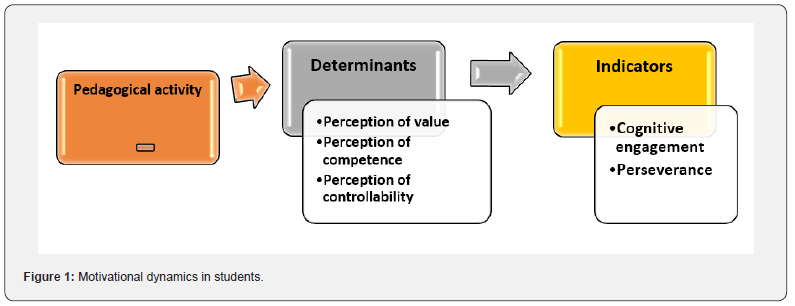
Methodological Framework
Research design and sample
In this exploratory study, we have chosen a quantitative approach using a questionnaire to collect data in order to answer the question: “What is the differential impact of teaching approaches with AR (Augmented Reality) and without AR on students’ emotions in the 9th grade?” and to test the following hypotheses:
• Hypothesis: There is an improvement in students’ perception of the “value of the activity” due to the use of augmented reality in learning.
• Hypothesis 2: There is a favorable change in students’ perception of “competence” due to the use of augmented reality in learning.
• Hypothesis 3: There is a favorable change in students’ perception of the “controllability of the activity” due to the use of augmented reality in learning.
The variables in our study are:
• The independent variable: “Use of AR in learning non-specific immunity.”
• The dependent variable: “Motivation,” which in our study is divided into three sub-variables (perception of value, perception of competence, perception of controllability) measured through their scores on tests.•
Development Questionnaire
The questionnaire is divided into three sections that cover the three dimensions: perception of value, perception of competence and perception of controllability, as shown in Table 1.
The questionnaire includes three types of questions: closed-ended multiple-choice questions. The questionnaire was administered to students at the beginning and end of the teaching sessions on the specific topic.
Sample: The target population consists of 42 students in the sixth grade, aged 11 to 13, from
a private school in Tunis. The experimentation took place during the 2021/2022 school year following the pedagogical progression in the Biology curriculum (2009). We formed two class groups, each consisting of 21 students. The first control group, noted as “T,” received instruction on non-specific immunity using a traditional pedagogical approach. The second experimental group, noted as “E,” received instruction on the same topic but with the introduction of ICT, specifically augmented reality. To evaluate the impact of AR on student motivation, the students underwent a pre-test and a post-test to assess the scores of motivation determinants and to verify the hypotheses regarding increased motivation among the learners in the experimental group compared to the control group.
Data Analysis Technique: To test the hypotheses, we calculated scores that reflect the self
assessment of the respondents in each dimension. The respondents filled out the questionnaire based on a four-point Likert scale, ranging from “Strongly Disagree” (1) to “Strongly Agree” (4). The numerical value assigned to each response corresponds to the option selected by the respondent on the response scale. However, for three questions (questions 3, 6, and 9), the scores are reversed to prevent students from perceiving a pattern. The descriptive analysis of the survey data is conducted using the statistical software SPSS.
Scoring Criteria
• Variable: Perception of value
The numerical value of the score for the “Perception of value” dimension corresponds to the sum of the numerical values assigned to each statement by the respondent using the response scale. If the response to a question is 1, note 1; if it is 2, note 2; if it is 3, note 3; and if it is 4, note 4. The score can range from 4 to 16.
- In the range [04, 8]: Low perception of value.
- In the range [08, 12]: Average perception of value.
- In the range [12, 16]: High perception of value
• Variable: Perception of competence
Perception of competence is assessed through questions 5, 6, 7, and 8. To calculate the score, the numerical value assigned to each statement is the one chosen by the respondent using the response scale. The score can range from 4 to 16.
- In the range [04, 8]: Low intensity perception of competence.
- In the range [08, 12]: Average intensity perception of competence.
- In the range [12, 16]: High intensity perception of competence
• Variable: Perception of controllability
Perception of controllability includes questions 9, 10, and 11. To calculate the score, the numerical value assigned to each statement is the one chosen by the respondent using the response scale. The score can range from 3 to 12.
- In the range [03, 6]: Low perception of controllability.
- In the range [06, 9]: Average perception of controllability.
- In the range [9, 12]: High perception of controllability
To assess the relationship between the perception of value, perception of competence, and perception of controllability in students’ learning of science, specifically the innate immune defense mechanism.
Study process design: We examined students’ conceptions regarding the composition of
blood tissue and the roles of blood cells in order to understand their prior knowledge, anticipate potential difficulties, and develop appropriate teaching strategies (Figure 2).
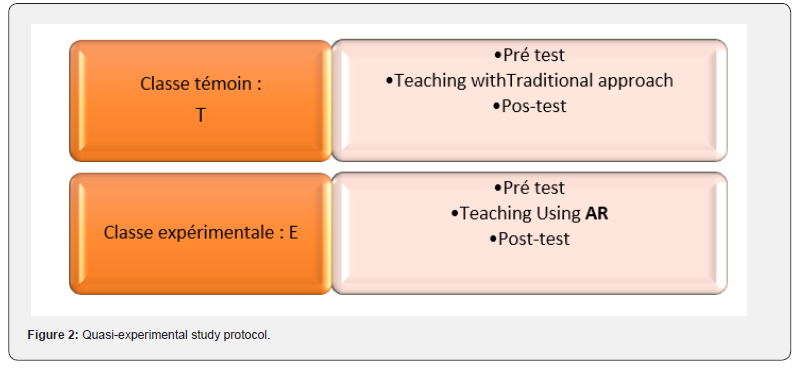
The enhancement of the non-specific immunity course was achieved by using AR technology with the assistance of an engineer specialized in educational technology. Based on our experience as former biology teachers, this particular part of the course tends to be challenging for students as it involves abstract concepts. By incorporating augmented reality, we aimed to facilitate students’ understanding of the non-specific immune response mechanism and help them grasp its significance more effectively (Figure 3a, 3b).
We conducted pre-tests and post-tests to assess students’ scores in relation to the three dimensions of academic motivation. Finally, we compared the post-test data to evaluate the impact of didactic interventions on academic motivation.
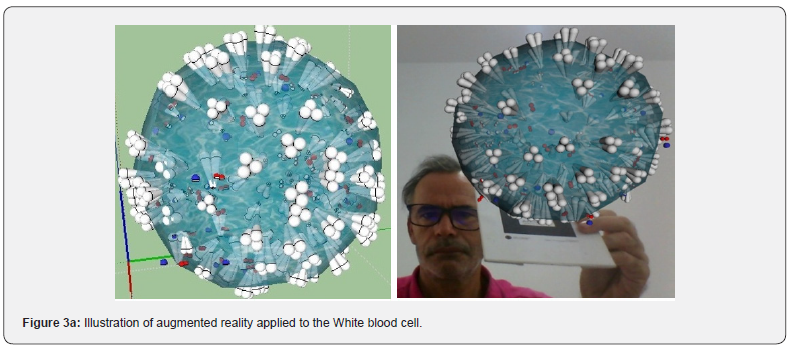
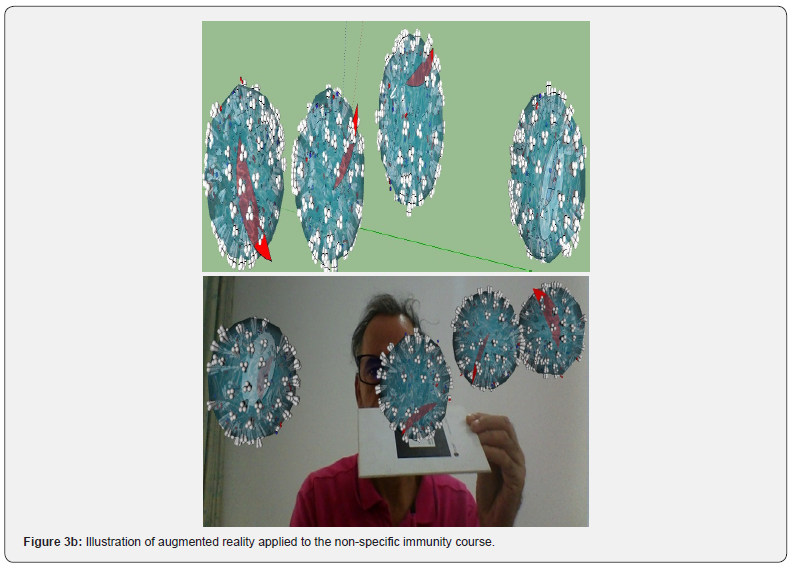
Results and Data Analysis
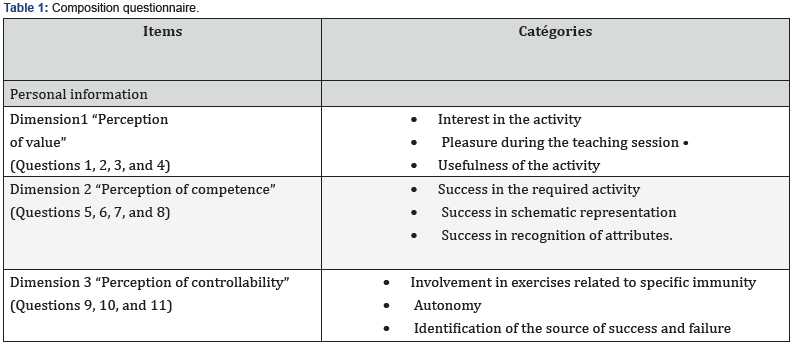

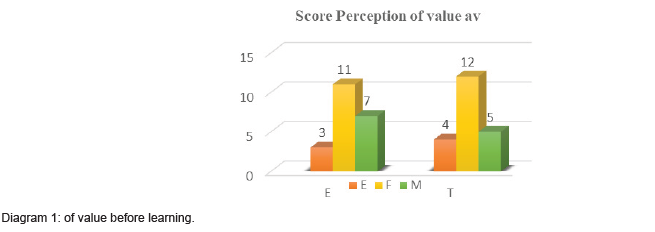

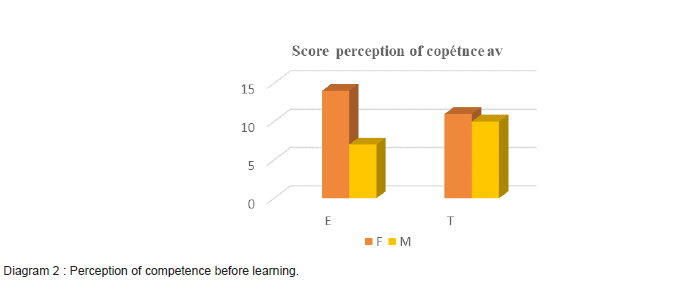
Descriptive analysis of scores in the three dimensions of academic motivation
Based on the responses provided by the students from classes T and E before the instructional intervention, the tables and graphs (1, 2, and 3) show the following observations:
a) Perception of value
• The scores for the perception of the value of the activity before the instructional intervention are low for both classes.
• This low score can be attributed to the students’ lack of interest and limited enjoyment of the activity.
• Additionally, the students do not fully recognize the usefulness and potential benefits of the activity. They fail to see the relevance and advantages they can gain from the teaching activity.
b) Perception of competence
• The students’ scores for their perceived ability to succeed in the given activity and their tendency to consider themselves capable of producing expected results indicate a predominantly low to moderate intensity of perception of competence for both classes.
• This suggests that the students’ self-perceived competence in the topic of immunity is generally limited or average in nature.
c) Perception of control
• The scores for the perception of control over learning the topic in question are predominantly low for both classes.
• The students’ level of effort and willingness to engage in the learning process of the immunity topic is low.
• The results from the pre-test suggest that students tend to passively undergo the teaching of the topic rather than actively taking control of their learning.
These observations indicate that prior to the instructional intervention, students in both classes displayed low scores in the perception of value, limited to moderate scores in the perception of competence, and low scores in the perception of control over learning. The results suggest that students were not fully engaged or motivated in learning the topic of immunity.
Based on the results from tables and graphs 5, 6, and 7, it can be inferred that students from the Control and Experimental classes demonstrated an improvement in the scores for the three determinants of academic motivation: perception of value, perception of competence, and perception of control. To test the hypotheses, statistical tests were conducted using the SPSS software for Windows (Statistical Package for the Social Sciences) with a confidence level of 95%.

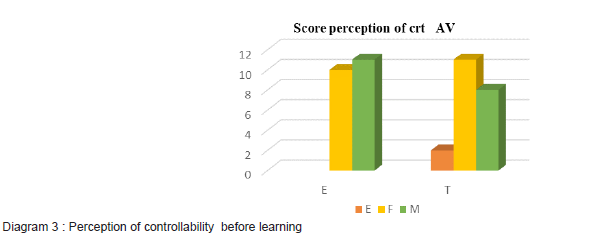



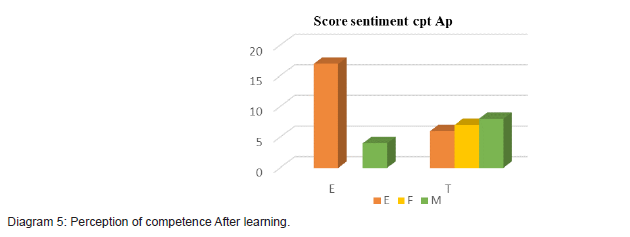

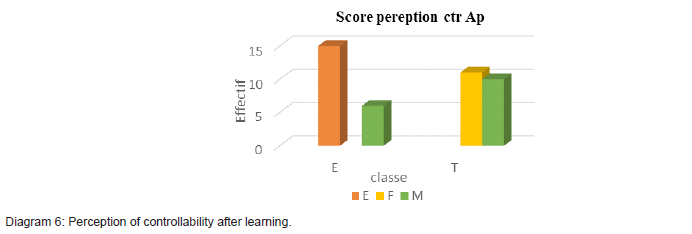
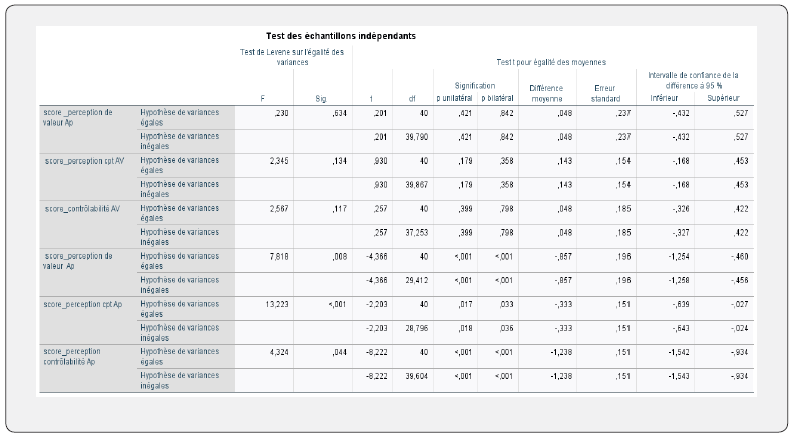
The statistical analysis reveals that there is no significant difference between the Control (T) and Experimental (E) groups for the three determinants of academic motivation before the pedagogical intervention. In fact, the results of the pre-test for both groups, T and E, suggest that students have a low sense of competence, hold a rather negative judgment about the interest and utility of the scientific learning situation, and demonstrate a low degree of control over the learning process. This supports the decline in academic motivation.
According to the hypothesis of our study, the use of augmented reality in teaching should impact students’ academic motivation. Indeed, for the E group, which benefited from the use of AR in the teaching situation, the scores for perception of competence, perception of activity value, and perception of control increased more significantly than for the T group that received traditional instruction. This difference was tested using an independent samples t-test. The results from the post-test scores revealed that the difference in scores for the three determinants of academic motivation among students favors the intervention with AR.
The significance of the relationship is indicated by the “p” values for the variables “perception of activity value,” “perception of competence,” and “perception of control,” with consecutive values of p < 0.001, p < 0.05, and p < 0.001, at a confidence level of 95%. This supports the effectiveness of augmented reality technology in the context of non-specific immunity in increasing the academic motivation of the experimental group in learning scientific concepts compared to the students in the control group. This increase in motivation is a result of changes in students’ perceptions. In fact, a positive perception of competence promotes the induction of pleasant emotions, increases the positive perception of activity value, and leads to a higher perception of control over the learning process.
Conclusion
The research focused on studying the impact of using augmented reality (AR) adapted for a non-specific immunity course for 9th-grade students in a Tunisian middle school. Following the integration of AR technology in teaching the course, we observed a significant increase in the academic motivation of the experimental group compared to the control group, as well as a positive trend in their perceptions of their competence, the value of the activity, and their control over it.
The statistical test comparing the means of independent samples (t-test) revealed statistically significant differences at the 0.05 level between the three perceptions of the control group and the experimental group. These differences favored the experimental group in terms of “perception of competence,” “perception of activity value,” and “perception of activity controllability.”
The research also demonstrated that the use of AR in learning has a positive impact on inducing positive perceptions among learners regarding their competence and the value of the activity, which provides meaning to the task at hand. This positive impact is reflected in the students’ engagement in the activity and their perseverance.
More than just a new technology, augmented reality allows learners to interactively revisit parts of the course that pose difficulties. Through its potential to offer immersive, personalized, and collaborative experiences, AR supports academic motivation by helping students feel competent in the proposed activities, perceive the usefulness of the instruction, and improve their perceived level of control over the activity. It is important to note that this study cannot claim to be exhaustive, and its conclusions are specific to the sample used. Further research avenues could be explored, including studies with larger cohorts and longer durations.
Overall, the findings of this study suggest that integrating augmented reality in the teaching of scientific concepts, such as non-specific immunity, has the potential to enhance students’ academic motivation and improve their perceptions, ultimately contributing to a more engaging and effective learning experience.
References
- Fridhi A, Bali N (2021) Science Education and Augmented Reality: Interaction of students with Avatars Modeled in Augmented Reality. International Journal of Environmental Science 6.
- Harrath Z, Bouajila A, Fridhi A (2023) Artificial Reality and Science Learning. Computer Science 18(4): 697-705.
- Bouajila A, Jebahi A, Fridhi, A. Use of Augmented Reality in Education.
- Zahira Merchant, Goetz E, Cifuentes L, Keeney-Kennicutt W, Davis T (2014) Effectiveness of virtual reality-based instruction on students' learning outcomes in K-12 and higher education: A meta-analysis. Computers & Education 70: 29-40
- Laribi R, Fridhi A, Rebai N (2021) The impact of augmented reality in improving non-verbal communication in children and young adults with autism spectrum disorder (ASD). International Journal of Education and Learning Systems, 6.
- Sommerauer P, Müller O (2014). Augmented reality in informal learning environments: A field experiment in a mathematics exhibition. Computers & Education 79: 59-68.
- Gobin P, Baltazart V, Simoës-Perlant A, Stefaniak N (2021). Émotions et apprentissages. Dunod.
- Genoud PA, Kappeler G, Gay P (2020) Faut-il former les enseignants afin qu’ils cherchent à diminuer les émotions négatives de leurs élèves ou qu’ils leur apprennent à renforcer leurs émotions positives? Recherches en éducation (41).
- Bouajila A, Jebahi A, Fridhi A, Bouraoui R. The Role of Educational Media in Motivation to Learn: Digital Media as a Model.
- Meyer DK, Turner JC (2002) Discovering emotion in classroom motivation research. Educational Psychologist 37(2): 107-114.
- Viau R (1994) La motivation en contexte scolaire. Montréal, QC: Éditions du renouveau pé
- Ryan RM, Deci EL (2000) Intrinsic and extrinsic motivations: Classic definitions and new directions. Contemporary educational psychology 25(1): 54-67.






























